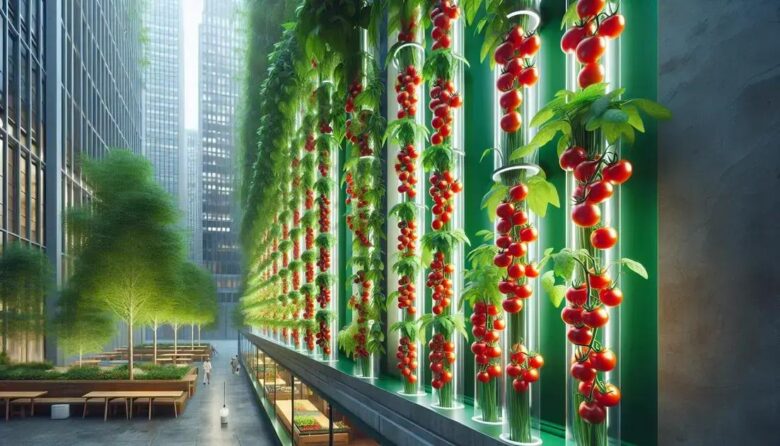Growing cherry tomatoes indoors using vertical grow tubes optimizes space by allowing more plants in limited areas, enhances light exposure and air circulation, and provides protection from pests and weather, making them an efficient method for year-round cultivation in small spaces.
Growing cherry tomatoes indoors can be both fun and rewarding. Using vertical grow tubes not only saves space but also enhances growth productivity. But how do you get started, and what should you look out for? Let’s dive in and explore the key steps and tips that will elevate your indoor gardening game!
advantages of growing cherry tomatoes indoors
Growing cherry tomatoes indoors offers many advantages that appeal to both hobbyists and seasoned gardeners. First, the controlled indoor environment can protect plants from pests and harsh weather, ensuring a stable and consistent growing condition throughout the year. No longer will you be at the mercy of unexpected frost or heat waves.
Additionally, indoor gardening allows you to optimize space effectively. You can grow cherry tomatoes in compact areas such as windowsills or balconies, and vertical growth methods further enhance productivity within these constraints. By positioning your plants close to natural light sources, such as south-facing windows, you can maximize light exposure, which is critical for their growth.
Another key benefit is the ability to monitor and manage plant nutrition closely. Indoor setups enable precise control over soil quality, watering schedules, and nutrient addition, leading to healthier plants and potentially higher yields. Plus, the convenience of having fresh tomatoes just steps away from your kitchen can’t be overstated, providing a steady supply of homegrown produce without the need for frequent trips to the grocery store.
Moreover, engaging in indoor gardening can be a therapeutic hobby and a rewarding family activity. It brings a piece of nature indoors, promoting a sense of calm and satisfaction as you watch your plants flourish and bear fruit.
how vertical grow tubes optimize space
Vertical grow tubes are an excellent method to optimize space when cultivating cherry tomatoes indoors. These tubes allow you to utilize vertical space effectively, transforming small areas into productive growing spots. By stacking plants vertically, you can increase the number of plants grown, which is essential in compact living spaces where horizontal space is limited.
Each plant in a vertical grow tube setup receives adequate light and air circulation, which are crucial for healthy growth. The design of the tubes ensures that every plant is at an optimal height for light absorption, reducing shading issues common in traditional horizontal gardening. This means more efficient photosynthesis and, subsequently, better yields.
Moreover, vertical tubes make maintenance tasks more manageable. Watering systems can be integrated to ensure consistent moisture levels, and nutrients can be delivered directly to each plant, promoting robust growth. Cleaning and harvesting are also simplified, as the plants are organized in a way that minimizes bending and reaching.
Overall, using vertical grow tubes is a smart space-saving strategy for indoor gardening enthusiasts. It maximizes productivity while keeping your indoor garden organized and efficient.
choosing the right grow tubes for cherry tomatoes
Selecting the right grow tubes for cherry tomatoes is crucial for a successful indoor gardening experience. When deciding on grow tubes, consider the material quality first. Durable materials like PVC provide stability and longevity, ensuring that your setup can withstand the plant’s growth cycle.
Another important factor is the diameter and height of the grow tubes. They should be large enough to accommodate the root systems of cherry tomatoes, promoting healthy development. This space allows for better air circulation and nutrient access for each plant.
Ensure that the grow tubes have adequate drainage holes. Proper drainage prevents waterlogging, which can lead to root rot and other issues. Well-designed systems often incorporate these features to maintain optimal soil moisture and plant health.
Consider the light availability in your chosen area. Transparent or semi-transparent tubes may help in maximizing light exposure, crucial for photosynthesis. Additionally, assess if the tubes can be easily integrated with automated watering systems, which help in maintaining consistent care.
By focusing on these details, you can create a conducive environment for your cherry tomatoes, leading to thriving plants and a rewarding indoor gardening experience.
step by step guide to indoor cultivation
Successful indoor cultivation of cherry tomatoes begins with selecting the right seeds or seedlings. Opt for varieties specifically designed for indoor growth. Once you have your seeds, plant them in rich potting soil within small starter pots or seedling trays. Keep the soil moist and position the pots in a warm area with indirect sunlight until sprouts appear.
After your seedlings have grown a few inches tall, it’s time for transplantation. Move the young plants into larger grow tubes filled with quality potting mix. Ensure each grow tube has proper drainage to avoid waterlogging. Place the tubes near a light source, such as a sunny window or under grow lights, to promote healthy growth.
Consistent watering and feeding are crucial. Water the plants regularly, keeping the soil moist but not soggy. Fertilize with a balanced tomato feed every two to four weeks to support flowering and fruiting. Pay attention to signs of nutrient deficiencies and adjust care as needed.
Pruning is another important step. Trim off any yellowing leaves or unnecessary stems to direct the plant’s energy towards fruit production. As the tomatoes start to form, check regularly for ripening and pests, picking tomatoes as they reach a vibrant red.
Finally, monitor your indoor conditions. Keep the temperature consistent and consider supplemental lighting if natural light is insufficient. By following these steps, you’ll enjoy a bountiful supply of fresh cherry tomatoes year-round.
common challenges and how to overcome them
Growing cherry tomatoes indoors presents unique challenges, but many can be overcome with proper strategies. One common issue is inadequate lighting, which can stunt growth. To address this, use grow lights to provide consistent light. Position them close to the plants and maintain them on a timer to simulate natural daylight cycles.
Pests can also pose a problem indoors. Despite being inside, plants can be attacked by aphids, spider mites, or whiteflies. Regularly check the leaves and stems for these pests and use insecticidal soap or neem oil as natural remedies.
Overwatering is another frequent challenge, as it leads to root rot. Ensure your pots and grow tubes have excellent drainage, and only water when the topsoil feels dry. Feel free to adjust your watering schedule based on the plant’s needs, which can vary with temperature and humidity.
Temperature fluctuations can stress plants, affecting their growth. Keep your indoor garden in a stable temperature range of 65-75°F. Avoid placing plants near drafts or heat sources, which can cause sudden temperature changes.
Finally, nutrient deficiencies can occur if the soil lacks essential minerals. Use a balanced fertilizer to provide necessary nutrients and monitor the plant’s health signs, like yellowing leaves, to make adjustments.
tips for maximizing yield in vertical setups
Maximizing yield in vertical setups involves a few smart strategies that can enhance growth and fruit production. Start by selecting high-yield cherry tomato varieties specifically suited for vertical growth. These varieties tend to have compact growth habits, which are ideal for tight spaces.
Next, ensure that your lighting is both adequate and properly positioned. Use LED grow lights to supplement natural sunlight, arranging them to cover all plants evenly. This ensures uniform light distribution, vital for even growth and fruit setting.
In vertical gardens, efficient use of space is key. Arrange plants in a staggered pattern within the grow tubes. This configuration maximizes light penetration and air circulation, reducing shading and promoting healthier plants.
Regular pruning is essential to maintain plant health and focus energy on fruit production. Trim any excessive foliage and non-fruiting stems. Pinching off suckers helps the plant direct nutrients toward the main stems and the fruits.
Finally, monitor your watering and feeding schedule closely. Employ a consistent watering routine using drip irrigation or self-watering systems to maintain an ideal moisture level. Fertilize the plants with a high-potassium formula to support fruit development and enhance yield.
Bringing your indoor tomato garden to life
Growing cherry tomatoes indoors using vertical systems is an exciting and rewarding venture. By understanding the advantages of indoor growing, selecting the right grow tubes, and optimizing your space effectively, you set the foundation for a thriving garden.
With a step-by-step guide and solutions to overcome challenges, you can ensure healthy plant growth. Employing techniques to maximize yield will help you enjoy the fruits of your labor.
Embrace the joy of indoor gardening, and relish the taste of fresh, homegrown cherry tomatoes, enhancing your culinary creations with produce grown just a few steps away.
FAQ – Frequently asked questions about indoor cherry tomato gardening
What are the benefits of growing cherry tomatoes indoors?
Growing cherry tomatoes indoors allows for year-round cultivation, protection from pests, and better control over environmental factors.
How do vertical grow tubes optimize space?
Vertical grow tubes utilize vertical space, allowing for more plants in a smaller area, maximizing light exposure and airflow.
What should I consider when choosing grow tubes for tomatoes?
Consider the material, size, drainage capabilities, and whether they can integrate with watering systems when selecting grow tubes.
What are common challenges in indoor tomato cultivation?
Common challenges include inadequate lighting, pests, overwatering, and temperature fluctuations, each requiring specific management strategies.
How can I maximize yield in a vertical setup?
To maximize yield, ensure even lighting, optimal planting arrangement, regular pruning, and proper nutrition and watering.
Can I grow cherry tomatoes indoors without natural sunlight?
Yes, you can use grow lights to provide the necessary light for photosynthesis when natural sunlight is insufficient.



